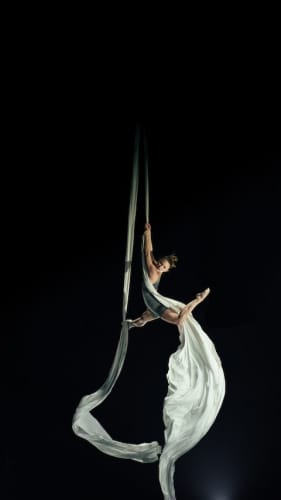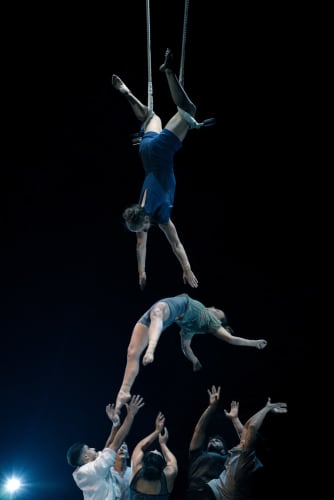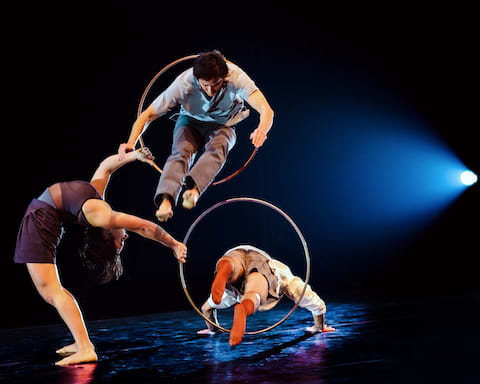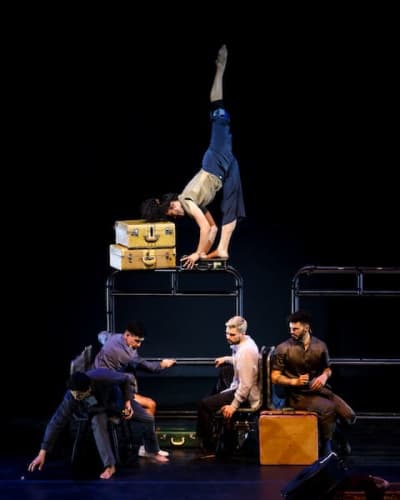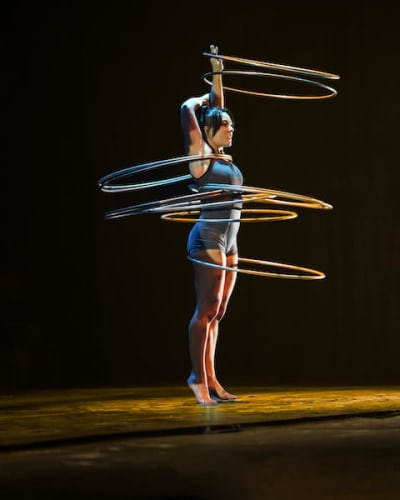As a critic, I often focus on opera and musicals. However, my life as a performer tended to different directions: choral music in one direction, and family and Theatre for Young Audiences (TYA; it’s counterpart is TYP, Theatre for Young Performers) in the other. Both have their rewards, but as an actor / singer / maybe even sometimes dancer, I was always drawn to theatre for families and for children.
As many have noted, the draw with that kind of work is the ability of younger and family audiences to engage directly with performers in a very immediate way and vice versa. When such theatre doesn’t work, it’s usually because the script or production has engaged heads and not hearts. Leave that for other plays and other audiences. But theatre that engages the body and thus the heart is often even more exciting.
In the case of circus and of shows such as Les 7 doigts de la main (The Seven Fingers) Passengers/Passagers, and because of the way such productions create a space for audiences of all ages, the “ohhhh”s and “oooohs” began within a few moments of a simple beginning.
The show starts with the old theatre exercise of breathing together and then turning the simple set of nine chairs into the central metaphor of the show, of travelling and trains, accompanied by lovely video projections created by video coordinator Dominique Hawry and video programmation by Laura-Rose R Grenier. The entire house is soon on the road with the nine performers, aided at first by a small projection screen with overlaying images that soon become as large or larger than the stage itself; this is another moment in which the simple became soon replaced by the complex.
The interview in the programme with author and director Shana Carroll tells us how the show began: “it seemed that [travel] was always where I took stock—that moment of limbo between lives, stuck in one place and yet nowhere geographically, motionless while in motion, captive only with your thoughts and some strangers.”
Once those moments of magic began, that particular magic of the cirque, the journey became rich, sometimes even fraught, as the performers pushed themselves and us into greater and greater danger. It’s one thing to juggle; it’s another thing to juggle with an ever increasing number of balls and to dealing with higher and higher heights as your fellow performers egg you on. I know, I’ve just described all juggling, but in this performance, as I read the moment, there was a playful tension between learned skill and pushing beyond that learned skill to the point of failure. It makes the game dangerous, as does sliding down a pole, head down from higher and higher heights, while being held only by ones’ feet and ankles.
Of course, the performers are no doubt trained in how to fall (all dancers and performers are if they do this kind of work), and no doubt they are often spotted by their fellow performers, but here’s the difference. To make something as highly skilled yet seemingly innocuous as juggling enter the realm of danger (shared by diving through hoops at even greater heights and distances and aerial work with fabric) is to push the space in which all forms of theatre exist to that of wonder. And, too, the moments that the cast acknowledged the rare failures of these gifted, hardworking people drew both cast and audience into a mass reflection on our own humanity and the concomitant need to risk failure in order to grow. We need to go too far to know we've gone far enough, at least for today.
I can’t communicate enough how varied and rich this entertainment is (all theatre, including circus, stems, historically at least, out of the impulse to define humanity and its possibilities). I’ll also note that while this particular run is ending soon (tickets, I can see from the web site, are going fast, so if you’re in the Seattle area, don’t miss this), the production is on tour, and there are other opportunities to see this production on its US tour and Taiwan.
Finally, I’ll add that Seattle Rep is committed to all kinds of diversity, including making the show available for ASL and assistive devices in its final Seattle performance on October 14, 2023.
